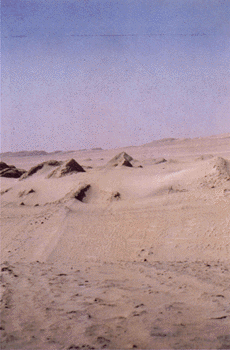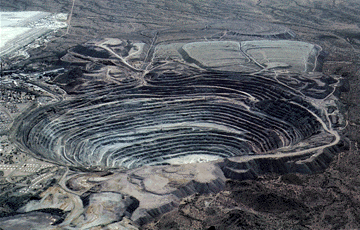




|
|
Nitrate workings in a broad valley in the Atacama Desert of northern Chile, where saline-cemented surficial deposits formed near a playa lake (photograph by George Ericksen). |
Evaporation in arid lands enriches mineral accumulation in their lakes. Playas may be sources of mineral deposits formed by evaporation. Water evaporating in closed basins precipitates minerals such as gypsum, salts (including sodium nitrate and sodium chloride), and borates. The minerals formed in these evaporite deposits depend on the composition and temperature of the saline waters at the time of deposition.
Significant evaporite resources occur in the Great Basin Desert of the United States, mineral deposits made forever famous by the "20-mule teams" that once hauled borax-laden wagons from Death Valley to the railroad. Boron, from borax and borate evaporites, is an essential ingredient in the manufacture of glass, ceramics, enamel, agricultural chemicals, water softeners, and pharmaceuticals. Borates are mined from evaporite deposits at Searles Lake, California, and other desert locations. The total value of chemicals that have been produced from Searles Lake substantially exceeds $1 billion.
The Atacama Desert of South America is unique among the deserts of the world in its great abundance of saline minerals. Sodium nitrate has been mined for explosives and fertilizer in the Atacama since the middle of the 19th century. Nearly 3 million metric tons were mined during World War I.
Valuable minerals located in arid lands include copper in the United States,
Chile, Peru, and Iran; iron and lead-zinc ore in Australia; chromite in Turkey;
and gold, silver, and uranium deposits in Australia and the United States.
Nonmetallic mineral resources and rocks such as beryllium, mica, lithium, clays,
pumice, and scoria also occur in arid regions. Sodium carbonate, sulfate, borate,
nitrate, lithium, bromine, iodine, calcium, and strontium compounds come from
sediments and near-surface brines formed by evaporation of inland bodies of
water, often during geologically recent times.

|
|
This open-pit mine in the Sonoran Desert near Ajo, Arizona, has exposed an elliptical copper deposit about 1,000 meters long and 750 meters wide. The copper ore mined here is in a bed that averages 150 meters in thickness (photograph by Peter Kresan). |
The Green River Formation of Colorado, Wyoming, and Utah contains alluvial fan deposits and playa evaporites created in a huge lake whose level fluctuated for millions of years. Economically significant deposits of trona, a major source of sodium compounds, and thick layers of oil shale were created in the arid environment.

|
|
Trona mine at Searles Lake, California (photograph by John Keith). |
Some of the more productive petroleum areas on Earth are found in arid and semiarid regions of Africa and the Mideast, although the oil reservoirs were originally formed in shallow marine environments. Recent climate change has placed these reservoirs in an arid environment.
Other oil reservoirs, however, are presumed to be eolian in origin and are
presently found in humid environments. The Rotliegendes, a hydrocarbon reservoir
in the North Sea, is associated with extensive evaporite deposits. Many of the
major U.S. hydrocarbon resources may come from eolian sands. Ancient alluvial fan
sequences may also be hydrocarbon reservoirs.




